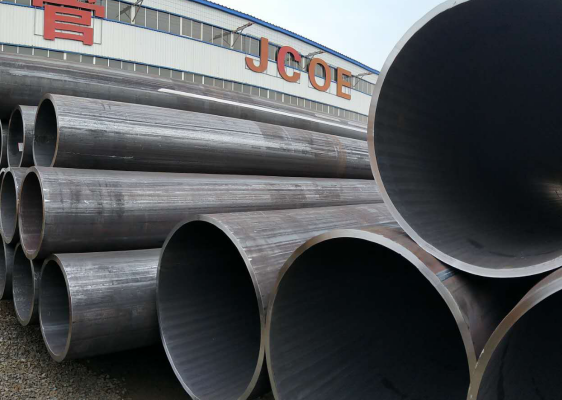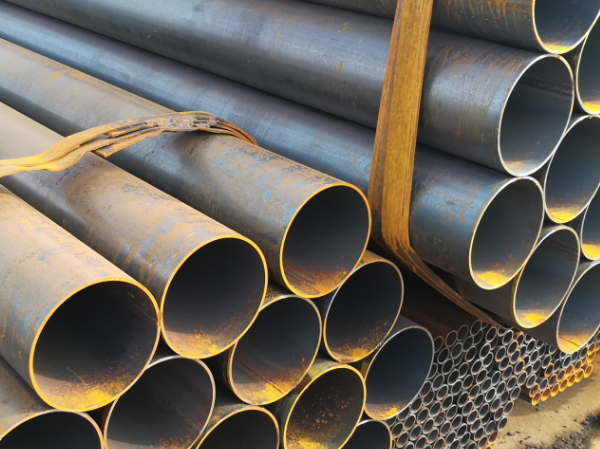
Types and Uses of Welded Steel Pipes
Types of Welded Steel Pipes:
Carbon steel welded pipes can be divided into three types according to the weld formation method: Longitudinal submerged arc welded steel pipes (LSAW), Spiral welded steel pipes (SSAW), and Electric resistance welded Steel Pipe (ERW, also called high-frequency straight seam welded steel pipes).
1) LSAW steel pipe (Longitudinal submerged arc welded steel pipe)
Longitudinal submerged arc steel pipe (LSAW pipe) is a steel pipe with a weld seam parallel to the longitudinal direction of the steel pipe. It is made of hot-rolled or cold-rolled steel plates or steel strips that are curled and welded. The production process of straight seam welded pipe is simple, the production efficiency is high, the cost is low, and the development is rapid. Straight seam steel pipes are widely used in water supply projects, petrochemical industry, chemical industry, electric power industry, agricultural irrigation, and urban construction.

2) SSAW steel pipe (Spiral welded steel pipe)
Spiral welded steel pipe (SSAW pipe) is made of strip steel coils as raw materials, rolled into tube blanks at a certain spiral angle, and then welded together. It can use narrow strip steel to produce large diameters. steel pipe. Spiral steel pipes are mainly used in drainage and water supply projects, fluid liquid, and solid transportation pipelines. It is widely used in urban construction and municipal engineering.
The strength of spiral welded pipes is generally higher than that of straight seam welded pipes. Welded pipes with larger diameters can be produced from narrower billets, and welded pipes with different diameters can also be produced from billets of the same width. However, compared with straight seam pipes of the same length, the weld length is increased by 30~100%, and the production speed is lower.
3) ERW steel pipe (Electric resistance welded steel pipe)
Electric resistance welded steel pipe (ERW pipe) uses the skin effect and proximity effect of high-frequency current to heat and melt the edge of the pipe blank after the hot rolled coil is formed by a forming machine, and presses it under the action of a squeeze roller Welding to achieve production. ERW has the characteristics of high efficiency,low cost,material saving and easy automation,it is widely used in aviation, aerospace, energy, electronics, automotive, light industry and other industrial sectors, is an important link in the welding process.
Advantages and disadvantages of welded steel pipes:
Advantages of welded steel pipes:
1. High efficiency and energy saving
The welding process of welded steel pipes uses advanced welding technology and materials, which results in high welding efficiency and low energy consumption. Compared with traditional pipes, it can greatly reduce costs and energy consumption. In addition, the specifications and length of welded steel pipes can be customized as needed, making them more convenient in transportation and installation.
2. Excellent mechanical properties
Welded steel pipes have thicker walls, higher strength and stiffness, and can withstand greater pressure and impact. At the same time, due to its excellent mechanical properties, welded steel pipes can be used in various complex terrains and environments, such as mountains, rivers, bridges, etc.
3. Good corrosion resistance
Welded steel pipes are specially treated and have better corrosion resistance. In corrosive media such as acids, alkalis, and salts, welded steel pipes can operate stably for a long time, ensuring the safety and service life of the pipeline.
4. Good pressure resistance
Another important advantage of welded steel pipe is its excellent pressure resistance. The use of welding technology makes the wall of the steel pipe uniform and dense, which can effectively improve the pressure resistance of the steel pipe and enable it to withstand greater internal pressure. Therefore, welded steel pipe is an indispensable pipeline material in some occasions that require high pressure resistance of pipelines, such as petroleum, natural gas, chemical industry and other fields.
5. High strength
Welded steel pipes use high-temperature fusion welding technology, which can effectively improve the strength and hardness of the pipe. The welded steel pipe not only has excellent strength and stiffness, but also can withstand greater pressure and load. Therefore, welded steel pipes are widely used in some situations that require high strength and stiffness of pipes, such as large machinery manufacturing, shipbuilding, pressure vessels and other fields.
6. Stable quality
Because welded steel pipes adopt a series of precise production processes and quality control measures, their quality is stable and reliable. In particular, the welding process adopts automated production technology, which greatly improves the quality stability of steel pipes, avoids many problems caused by different technical levels of workers or poor welding joint quality in manual welding, and ensures the quality of steel pipes and welding quality.
7. Convenient construction
Another advantage of welded steel pipes is that they are easy to construct and can quickly complete the pipe welding work and improve construction efficiency. Compared with traditional cast pipes, welded steel pipes have a more flexible construction method and can be cut and spliced as needed, making them suitable for various occasions.
8. Environmental protection and health
During the production and use of welded steel pipes, no harmful substances and odors will be produced. At the same time, due to its good corrosion resistance, it can reduce the cleaning and maintenance work of pipelines and reduce the impact on the environment.
9. Reusable
Welded steel pipes have thicker walls and can be reused multiple times after inspection and treatment. This not only reduces costs, but also reduces resource waste and environmental pollution.
10. Wide range of application
Welded steel pipes are suitable for various fields and industries, such as construction, petroleum, chemical industry, light industry, machinery, etc. Its excellent mechanical properties and corrosion resistance enable it to operate stably in a variety of environments.

Disadvantages of welded steel pipe: Seamlsss VS Welded Pipe
During the welding manufacturing process, if the welding technology is not up to standard, the joints may have problems such as incomplete penetration and unsealed welds, which may lead to water leakage, air leakage, etc. after welded pipe construction.
2. Susceptible to corrosion
Because the surface of the welded pipe does not receive special anti-corrosion treatment, if it encounters high humidity, high oxides and other environments during use, it is easy to cause rust and wear on the surface of the welded pipe. Compared with seamless steel tubes, the welds of straight seam welded pipes are more susceptible to corrosion by chemical substances. During use, if harmful substances such as strong acids and alkalis are encountered, the metal structure at the weld may be corroded, resulting in pipeline failure, rupture, leakage and other safety issues.
3. Poor surface quality
Since the production process of straight seam welded pipes requires multiple processes such as billet curling, cold bending, and heat straightening, it is difficult to guarantee the surface quality of the pipes. For example, unevenness in the welding joint, residual moisture, grease and other impurities will adversely affect the performance and service life of the pipeline.
4. The pressure resistance is not as good as seamless steel pipe
There is a certain degree of stress concentration in the internal welds of straight seam welded pipes, but seamless steel pipes do not have this defect. This makes the straight seam welded pipe have limited pressure resistance under harsh conditions such as high temperature and high pressure, and is prone to cracks, deformation and other problems.
5. Poor dimensional accuracy
Due to the influence of the production process, the dimensional accuracy of straight seam welded pipes is often worse than that of seamless steel pipes. In some situations, such as applications that require high-precision processing and high sealing performance, straight seam welded pipes may not be suitable.
The main uses and applications of welded steel pipes are as follows:
1. Conveying pipelines
Welded steel pipes are widely used to transport oil, natural gas, gas, water and other fluids, especially in urban gas and water supply systems.
2. Structural pipe
Welded steel pipes are used in engineering fields such as building structures, bridges, steel frames, and supports. They have good bearing capacity and shock resistance.
3. Electric power industry
Welded pipes are also suitable for transportation pipelines in the electric power industry. Among them, high voltage power transmission and gas transmission, low voltage power distribution and gas transmission, underground gas pipeline, heat pipeline, urban gas pipeline and other places are also commonly used welded pipe as a conveying pipeline materials.
4. Machinery manufacturing
Welded steel pipes can be used to manufacture various mechanical parts, such as shafts, brackets, conveyor rollers, etc.
5. Oil and gas drilling
Welded steel pipes can be used in the manufacture of oil and gas drilling and oil production equipment, such as drill pipes, casings, etc.
6. Tower Fabrication: Welded steel pipes are used in the fabrication of broadcasting and communication towers.
7. Greenhouses: Welded steel pipes are often used in the manufacture of supports for greenhouses due to their lower cost and better strength.
8. Bicycle and motorcycle manufacturing: Welded steel pipes are used to make the frames of bicycles and motorcycles.
9. Furniture manufacturing: Welded steel pipes can be used to produce various furniture such as bed frames, bookshelves, chairs, etc.
Overall, as a widely used steel pipe, welded pipe has many advantages, including low cost, wide applicability of materials and so on. The above brief description of the welded pipe abbreviation and its application is only one part, they have many other applications and abbreviations, we can further understand and apply in the actual production and use.


